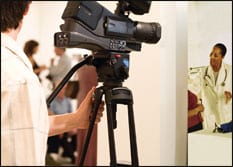 |
It can be a major turning point in the careers of most physicians—the decision to lease or buy the building in which they practice or will be practicing.
In many cases, we profess that it is better to own versus rent. This article provides a brief overview of the pros and cons of each, as well as what you must know before you make the correct choice based on your individual needs and goals.
SHOULD YOU PURCHASE?
If someone said, “If you buy a building and make the down payment, I will pay your mortgage and you will own the building at the end,” would you do it? Of course you would. You might have the opportunity to buy a building, and your practice might be willing to pay the mortgage. Remember, your practice needs to pay someone for office space, so why not you?
All this sounds good as long as there is assurance that someone will be paying the rent that will be used to pay the mortgage.
Therefore, first and foremost, you need to determine if you (and your associates) will be practicing in a geographic location with which you are familiar. Also, will you be there for a long time?
If the answer is yes, then you should consider buying. However, if the answer is no, or if you are not sure, then you should probably lease, as there are no guarantees that real estate values will rapidly appreciate or that you will be able to recoup your costs in the event you need to sell shortly after the purchase.
Most physicians who are new to a community should initially rent. Only after you are confident that you and your family like the community and you are able to establish a practice there should you consider purchasing a building.
WHAT TO BUY?
Most communities have different zoning requirements for medical practices than they do for other commercial uses. As a result, you will need a building that is or can be zoned for medical use. Available parking is the greatest determining factor for whether or not a suburban or rural area building can be used for a medical practice.
Before you commit to any building, you might want to retain the services of a real estate broker who has represented other medical practices and/or is familiar with the needs of physicians. You might also want to make a visit to the town’s building and zoning department in order to ensure that you will be able to use the building for your practice.
What is the potential appreciation of the property? It’s like the real estate agent’s mantra: “location, location, location.” That is the number one rule in real estate, and it’s often the most overlooked.
If you are considering the purchase of a building as an investment, you need to consider where it is situated, how desirable the area is, and how much the property is likely to appreciate over time. This is often a function of supply and demand and potential uses of the space.
If you are buying a building that can be used for multiple purposes and is in an area with a limited number of existing buildings and limited vacant lots, it should appreciate over time.
WHY DON’T ALL PHYSICIANS PURCHASE THEIR BUILDING?
The cash flow from a building is a function of rental income (even if you are the tenant) minus the landlord’s expenses (even if you are the landlord). Will a fair rental rate (based on area rates) cover your expenses?
Often, the answer initially is no. You will not only need to come up with the down
payment, you will most likely need to cover a loss in the early years resulting from expenses that exceed the rent.
However, if you have a fixed interest rate on your mortgage, the monthly payments will remain the same over its term. Meanwhile, most leases (and area fair rental rates) increase over time. As a result, although the initial fair rental rate may not cover the building costs, hopefully—over the long run—the monthly payments will not only cover the operating costs but will generate a profit.
Once the mortgage is paid off, the profit becomes substantial. The real question is, can you come up with the down payment and the funds needed to cover any initial loss?
In addition, there is a potential tax benefit from owning a building. Ideally, the medical practice would pay market value rent to the entity that owns the building. This allows the medical practice and building-owner physicians to convert operating income (which is subject to self-employment tax) to rental income (which is not subject to self-employment tax).
AVOIDING ADDITIONAL LOSSES
 |
The greatest risk in commercial real estate is vacancy. Whereas most landlords are confident they will have tenants, vacancies still occur.
You need to make sure that you are realistic when determining the amount of space that you will need for your practice. If you are overly aggressive and buy “too big,” you are faced with the risk of vacancy. This can create a huge problem and have a negative impact on your cash flow—especially if you are planning to offset some of your costs by leasing space to other physicians and then discover that nobody is interested.
Space is measured in square feet. A rule of thumb for the size of a practice facility is 1,200 to 1,500 square feet for the first physician and 1,000 to 1,200 square feet for each additional physician, up to four or five.1
If you own the building, for the most part, you can make virtually unlimited improvements to the space. However, you must be careful to do an analysis of what rental rate you would need to recoup those costs.
For example, if you spend too much money and can no longer charge a reasonable rate in the event you need to rent space, you might not be able to recover your costs.
WHO SHOULD OWN THEIR OWN REAL ESTATE?
Many group practices don’t buy a building because not all members of the group want to own a building. This is often a mistake. The group will be paying rent to someone, regardless. Why not pay rent to some of the partners? However, if you decide to purchase the building, then you must be sure that your medical practice does not own the building—this is important for both income tax as well as asset-protection purposes.
No matter how skilled you and your partners are, if you see enough patients then eventually you will be sued. If your practice owns the real estate, that property is subject to claims of creditors from your medical practice.
However, if the building is owned by a separate entity such as a limited liability company (LLC), it would not be subject to any creditors associated with your medical practice.
Additionally, if there are several physicians in your practice and not all of them want to or can afford to own the building, only those interested need make the purchase. The others can remain shareholders in the medical practice and not be involved with ownership of the building.
This strategy would also allow physicians who have retired from the practice to continue to receive rental payments via their LLC ownership interest, even though they are no longer practicing medicine.
As long as the landlord (the physicians involved in the real estate entity) charges the tenant (the medical practice) a competitive rental rate, the physicians who have not invested in the property should not object to paying rent to a landlord they know. However, some physicians may begrudge their partners making money or building equity when they, in fact, are not. For this reason, all partners in the medical practice (not necessarily employed physicians) should be given an opportunity to invest in the real estate entity. If they choose not to invest, and the rent the practice pays is fair, then they should not object to others investing.
Finally, if your children are of age, you might even consider having them own the real estate or you can gift ownership interests to them over time as part of your overall financial plan. Under the right circumstances, these strategies may help you accomplish both your income and estate-planning goals.
Regardless of whether you or your children own the real estate entity, the real estate entity should have clear partnership contracts and a clearly defined lease with the practice.
The real estate partnership agreement should cover issues such as profit distribution, management responsibilities, and when and how a partner must sell his/her interests in the real estate partnership.
Some medical real estate partnerships require the physician to give partners the option of buying his interests in the real estate when he or she stops practicing. This gives the remaining partners an increased ability to sell shares to new physicians who join the group.
In addition to the rental rate and term of the lease, the lease should clearly articulate which expenses are the responsibility of the tenant and which ones are the domain of the landlord.
SHOULD YOU RENT?
|
See also “Does the Human Face Age Uniformly?” by Rima Bedevian in the November 2007 issue of PSP. |
 |
If you don’t have the money for a down payment or are going to practice in an unfamiliar geographical area, it is probably best for you to rent—at least initially. This strategy gives you the time necessary to make sure that things are working out before you part with a large amount of money.
Renting also allows you the flexibility to move in case you decide to relocate. Other than being subject to rent increases, you don’t have a vested interest if the underlying property increases in value or not.
However, lease terms are limited, and at some point they will need to be renegotiated. What happens if your landlord wants you to vacate the property upon renewal and your practice is booming? For this reason, it is wise to have guaranteed options to renew, even if they need to be renegotiated at a higher rate.
CONCLUSION
Renting provides a good short-term solution, but at the end of the day someone else is building equity. If you know that you are going to be practicing for a long time and you don’t have great investment opportunities elsewhere, owning the building that holds your practice is something to strongly consider.
Lawrence B. Keller, CFP, is the founder of Physician Financial Services, a New York-based firm specializing in income-protection and wealth-accumulation strategies for physicians. He can be reached at (516) 677-6211 or .
Michael J. Wiley, CHBC, is the president of Healthcare Management & Consulting Services Inc. He has more than 25 years of experience as a health care management consultant, with extensive experience in advising solo practice start-ups, as well as large multispecialty medical groups. He can be reached at (631) 665-0439 or .
REFERENCE
- Maresh OK. Choosing a practice facility. Fam Pract Manag. 2002;9:37-41.





